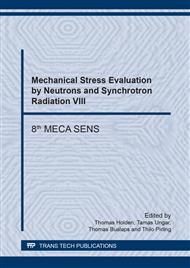[1]
R. Z. Valiev and T. G. Langdon, Principles of equal-channel angular pressing as a processing tool for grain refinement, Prog. Mater. Sci., 51 (2006) 881–981.
DOI: 10.1016/j.pmatsci.2006.02.003
Google Scholar
[2]
C. Reyes-Ruiz, I. A. Figueroa, C. Braham, J. M. Cabrera, I. Alfonso, and G. Gonzalez, Texture and lattice distortion study of an Al-6061-T6 alloy produced by ECAP, Mater. Trans. Article in press.
DOI: 10.2320/matertrans.m2015200
Google Scholar
[3]
M. A. Meyers, A. Mishra, and D. J. Benson, Mechanical properties of nanocrystalline materials, Prog. Mater. Sci., 51 (2006) 427–556.
Google Scholar
[4]
G. Gonzalez, C. Braham, J. L. Lebrun, Y. Chastel, W. Seiler, and I. A. Figueroa, Microstructure and Texture of Al 2Si x Sn ( x = 0 , 4 , 8 mass % ) Alloys Processed by Equal Channel Angular Pressing, Mater. Trans., 53 (2012) 1234–1239.
DOI: 10.2320/matertrans.m2012011
Google Scholar
[5]
S. N. Alhajeri, N. Gao, and T. G. Langdon, Hardness homogeneity on longitudinal and transverse sections of an aluminum alloy processed by ECAP, Mater. Sci. Eng. A, 528, (2011) 3833–3840.
DOI: 10.1016/j.msea.2011.01.074
Google Scholar
[6]
A. P. Zhilyaev, D. L. Swisher, K. Oh-ishi, T. G. Langdon, and T. R. McNelley, Microtexture and microstructure evolution during processing of pure aluminum by repetitive ECAP, Mater. Sci. Eng. A, 429 (2006) 137–148.
DOI: 10.1016/j.msea.2006.08.001
Google Scholar
[7]
C. Hernandez, I. A. Figueroa, I. Alfonso, C. Braham, P. Castillo, and G. Gonzalez, Microstructure and texture evolution of the Al-20sn alloy procesed by equal-channel angular pressing using route C, Mater. Trans., 56 (2015) 40–45.
DOI: 10.2320/matertrans.m2014225
Google Scholar
[8]
F. Djavanroodi, B. Omranpour, M. Ebrahimi, and M. Sedighi, Designing of ECAP parameters based on strain distribution uniformity, Prog. Nat. Sci. Mater. Int., 22 (2012) 452–460.
DOI: 10.1016/j.pnsc.2012.08.001
Google Scholar
[9]
S. K. Lu, H. Y. Liu, L. Yu, Y. L. Jiang, and J. H. Su, 3D FEM simulations for the homogeneity of plastic deformation in aluminum alloy HS6061-T6 during ECAP, Procedia Eng., 12 (2011) 35–40.
DOI: 10.1016/j.proeng.2011.05.007
Google Scholar
[10]
F. Cioffi, J. I. Hidalgo, R. Fernández, T. Pirling, B. Fernández, D. Gesto, I. Puente Orench, P. Rey, and G. González-Doncel, Analysis of the unstressed lattice spacing, d0, for the determination of the residual stress in a friction stir welded plate of an age-hardenable aluminum alloy - Use of equilibrium conditions and a genetic algorithm, Acta Mater., 74 (2014).
DOI: 10.1016/j.actamat.2014.04.035
Google Scholar
[11]
M. Mahmoodi, M. Sedighi, and D. a. Tanner, Investigation of through thickness residual stress distribution in equal channel angular rolled Al 5083 alloy by layer removal technique and X-ray diffraction, Mater. Des., 40 (2012) 516–520.
DOI: 10.1016/j.matdes.2012.03.029
Google Scholar
[12]
I. -F. Lee, T. Q. Phan, L. E. Levine, J. Z. Tischler, P. T. Geantil, Y. Huang, T. G. Langdon, and M. E. Kassner, Using X-ray microbeam diffraction to study the long-range internal stresses in aluminum processed by ECAP, Acta Mater., 61(2013).
DOI: 10.1016/j.actamat.2013.09.013
Google Scholar
[13]
A. Wanner and D. C. Dunand, Synchrotron X-ray study of bulk lattice strains in externally loaded Cu-Mo composites, Metall. Mater. Trans. A, 31 (2000) 2949–2962.
DOI: 10.1007/bf02830344
Google Scholar
[14]
J. Romero, M. Preuss, and J. Quinta da Fonseca, Capturing the texture changes in a zirconium alloy during the allotropic phase transformation, Scr. Mater., 61 (2009) 399–402.
DOI: 10.1016/j.scriptamat.2009.04.031
Google Scholar
[15]
A. P. Hammersley, S. O. Svensson, M. Hanfland, a. N. Fitch, and D. Hausermann, Two-dimensional detector software: From real detector to idealised image or two-theta scan, High Press. Res., 14 (1996) 235–248.
DOI: 10.1080/08957959608201408
Google Scholar
[16]
ABAQUS Inc., ABAQUS 6. 9 Analysis User's Manual.
Google Scholar
[17]
E. Cerri, P. P. De Marco, and P. Leo, FEM and metallurgical analysis of modified 6082 aluminium alloys processed by multipass ECAP: Influence of material properties and different process settings on induced plastic strain, J. Mater. Process. Technol., 209 (2009).
DOI: 10.1016/j.jmatprotec.2008.04.013
Google Scholar
[18]
C. Xu, M. Furukawa, Z. Horita, and T. G. Langdon, The evolution of homogeneity and grain refinement during equal-channel angular pressing: A model for grain refinement in ECAP, Mater. Sci. Eng. A, 398 (2005) 66–76.
DOI: 10.1016/j.msea.2005.03.083
Google Scholar
[19]
Y. Iwahashi, J. Wang, Z. Horita, M. Nemoto, and T. G. Langdon, Principle of equal-channel angular pressing for the processing of ultra-fine grained materials, Scr. Mater., 35 (1996) 143–146.
DOI: 10.1016/1359-6462(96)00107-8
Google Scholar


